Effective Leadership Theories and Practices
VerifiedAdded on 2020/11/23
|18
|5435
|134
Essay
AI Summary
This assignment delves into the world of leadership, examining different theoretical frameworks and practical applications. It requires students to analyze and compare various leadership styles, understand their effectiveness in different contexts, and critically evaluate the influence of leadership on individuals and organizations. The provided resources offer insights into diverse aspects of leadership, from emotional intelligence and cultural sensitivity to managing knowledge workers and leading positive performance.
Contribute Materials
Your contribution can guide someone’s learning journey. Share your
documents today.
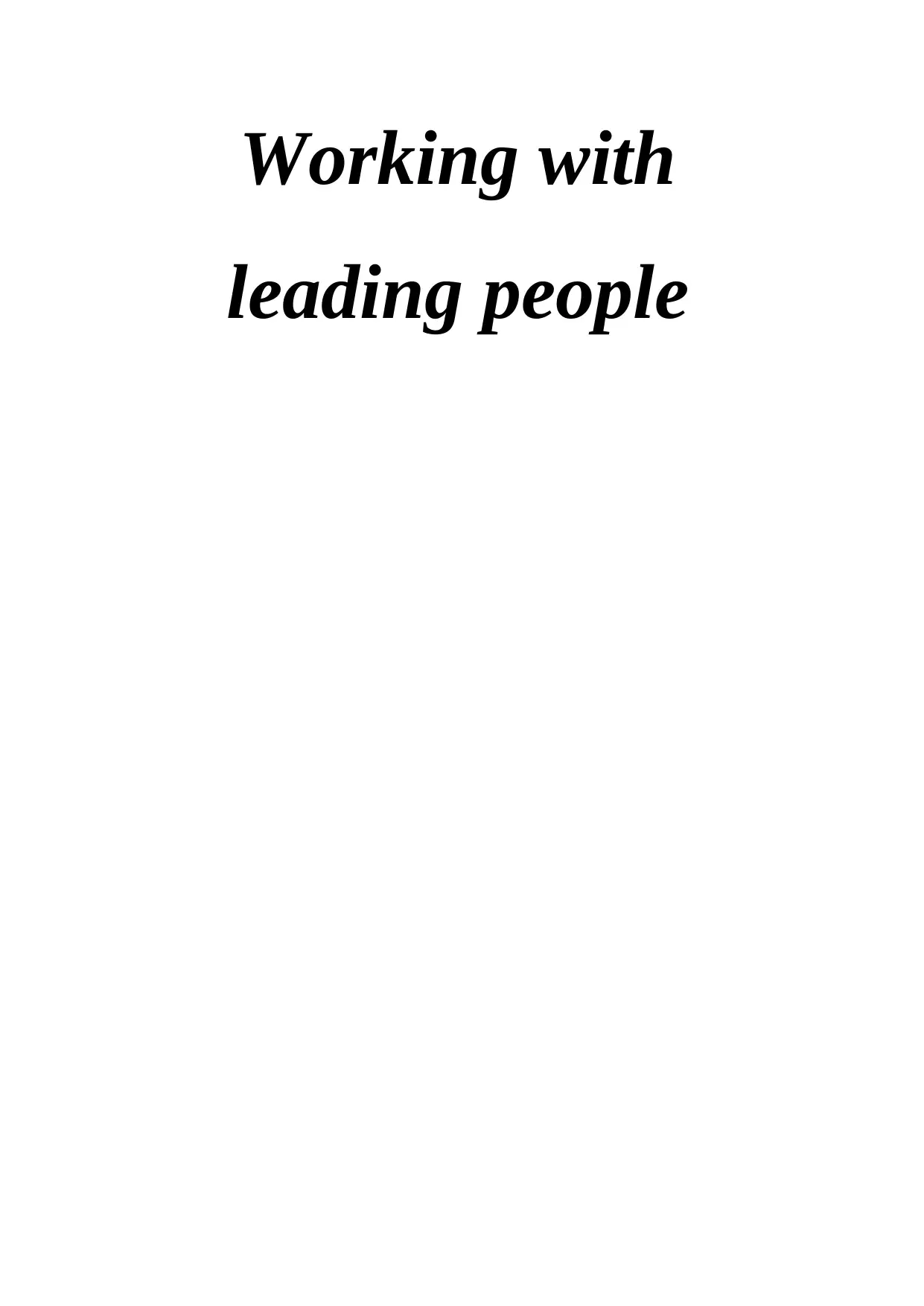
Working with
leading people
leading people
Secure Best Marks with AI Grader
Need help grading? Try our AI Grader for instant feedback on your assignments.
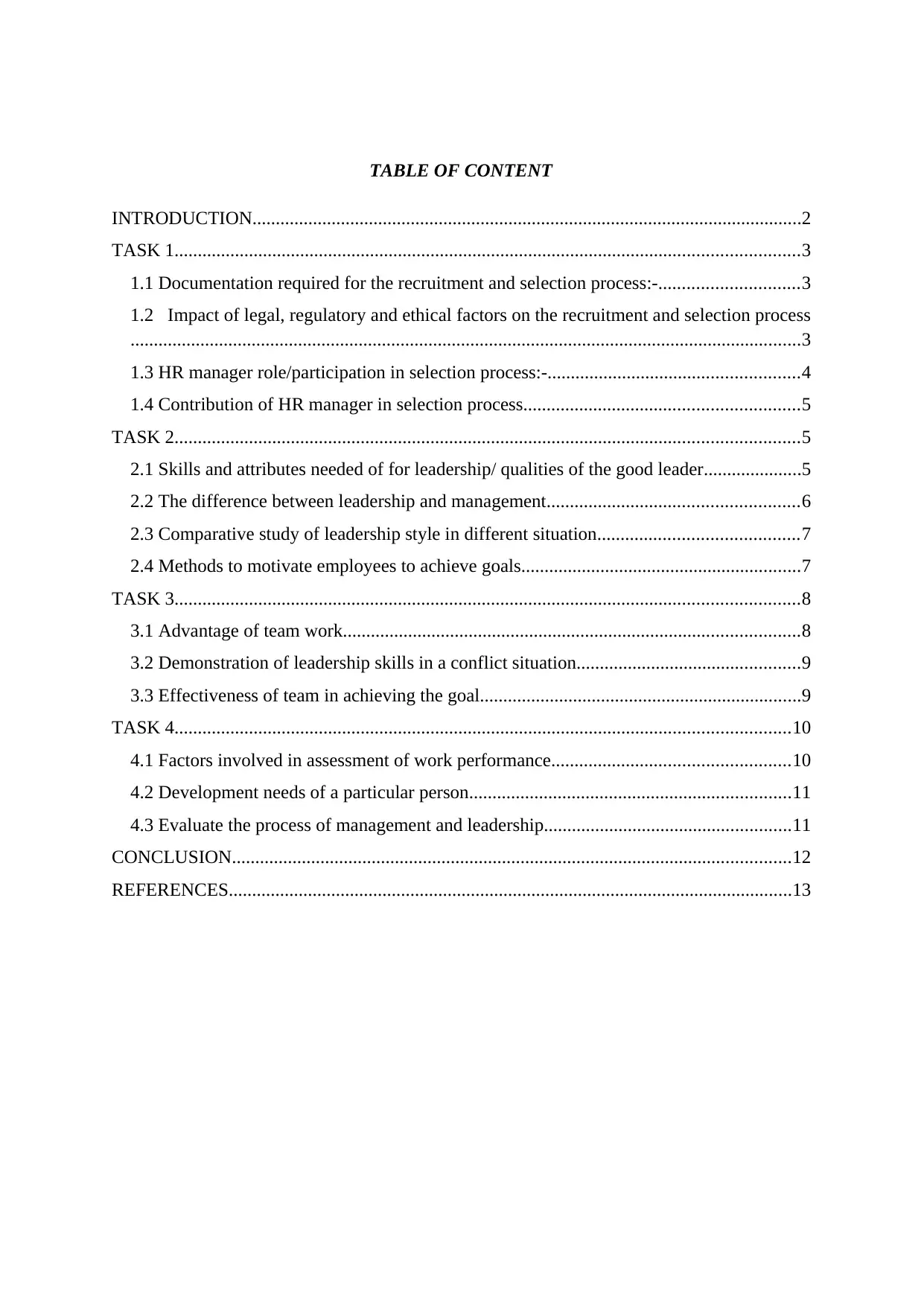
TABLE OF CONTENT
INTRODUCTION......................................................................................................................2
TASK 1......................................................................................................................................3
1.1 Documentation required for the recruitment and selection process:-..............................3
1.2 Impact of legal, regulatory and ethical factors on the recruitment and selection process
................................................................................................................................................3
1.3 HR manager role/participation in selection process:-......................................................4
1.4 Contribution of HR manager in selection process...........................................................5
TASK 2......................................................................................................................................5
2.1 Skills and attributes needed of for leadership/ qualities of the good leader.....................5
2.2 The difference between leadership and management......................................................6
2.3 Comparative study of leadership style in different situation...........................................7
2.4 Methods to motivate employees to achieve goals............................................................7
TASK 3......................................................................................................................................8
3.1 Advantage of team work..................................................................................................8
3.2 Demonstration of leadership skills in a conflict situation................................................9
3.3 Effectiveness of team in achieving the goal.....................................................................9
TASK 4....................................................................................................................................10
4.1 Factors involved in assessment of work performance...................................................10
4.2 Development needs of a particular person.....................................................................11
4.3 Evaluate the process of management and leadership.....................................................11
CONCLUSION........................................................................................................................12
REFERENCES.........................................................................................................................13
INTRODUCTION......................................................................................................................2
TASK 1......................................................................................................................................3
1.1 Documentation required for the recruitment and selection process:-..............................3
1.2 Impact of legal, regulatory and ethical factors on the recruitment and selection process
................................................................................................................................................3
1.3 HR manager role/participation in selection process:-......................................................4
1.4 Contribution of HR manager in selection process...........................................................5
TASK 2......................................................................................................................................5
2.1 Skills and attributes needed of for leadership/ qualities of the good leader.....................5
2.2 The difference between leadership and management......................................................6
2.3 Comparative study of leadership style in different situation...........................................7
2.4 Methods to motivate employees to achieve goals............................................................7
TASK 3......................................................................................................................................8
3.1 Advantage of team work..................................................................................................8
3.2 Demonstration of leadership skills in a conflict situation................................................9
3.3 Effectiveness of team in achieving the goal.....................................................................9
TASK 4....................................................................................................................................10
4.1 Factors involved in assessment of work performance...................................................10
4.2 Development needs of a particular person.....................................................................11
4.3 Evaluate the process of management and leadership.....................................................11
CONCLUSION........................................................................................................................12
REFERENCES.........................................................................................................................13
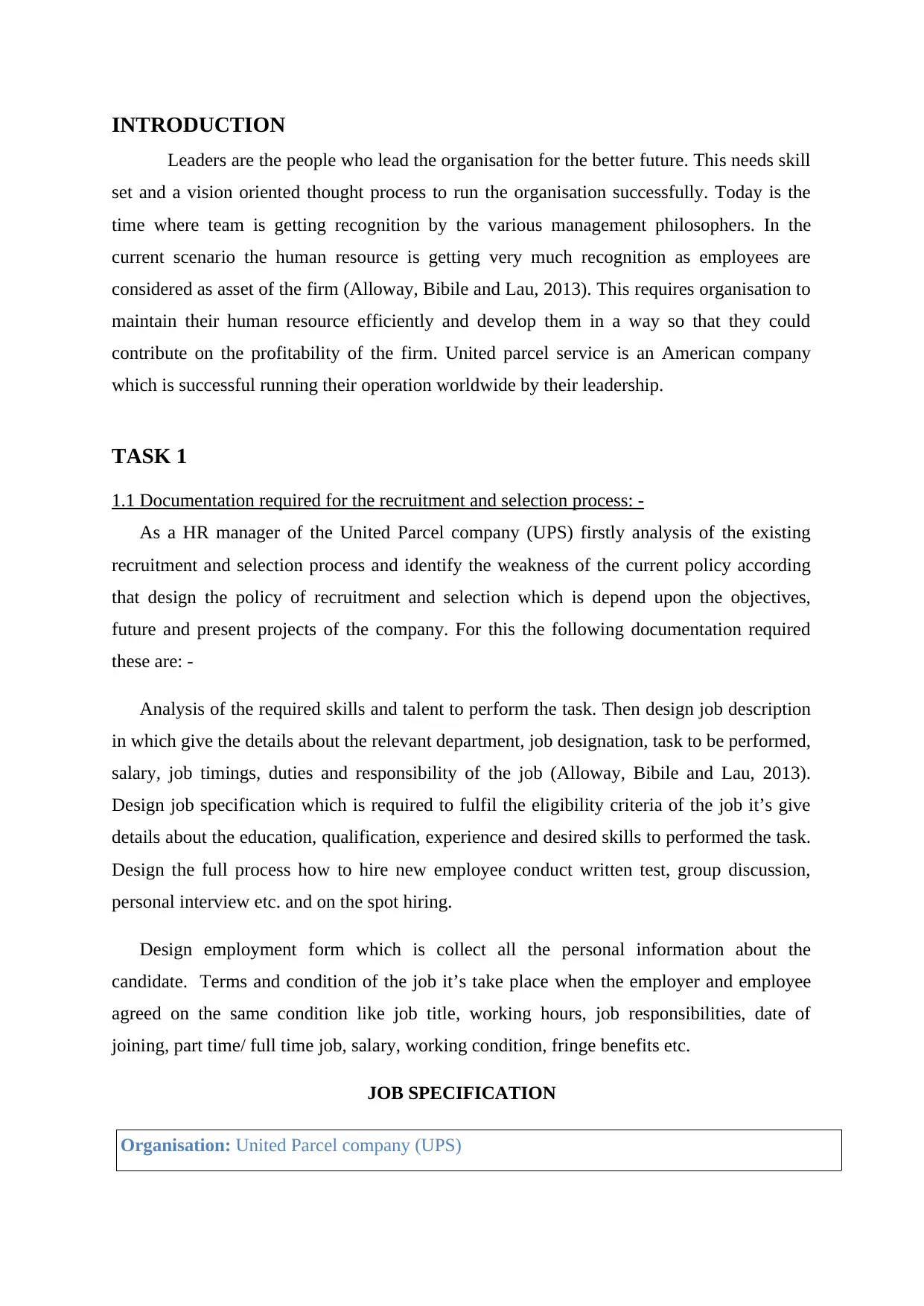
INTRODUCTION
Leaders are the people who lead the organisation for the better future. This needs skill
set and a vision oriented thought process to run the organisation successfully. Today is the
time where team is getting recognition by the various management philosophers. In the
current scenario the human resource is getting very much recognition as employees are
considered as asset of the firm (Alloway, Bibile and Lau, 2013). This requires organisation to
maintain their human resource efficiently and develop them in a way so that they could
contribute on the profitability of the firm. United parcel service is an American company
which is successful running their operation worldwide by their leadership.
TASK 1
1.1 Documentation required for the recruitment and selection process: -
As a HR manager of the United Parcel company (UPS) firstly analysis of the existing
recruitment and selection process and identify the weakness of the current policy according
that design the policy of recruitment and selection which is depend upon the objectives,
future and present projects of the company. For this the following documentation required
these are: -
Analysis of the required skills and talent to perform the task. Then design job description
in which give the details about the relevant department, job designation, task to be performed,
salary, job timings, duties and responsibility of the job (Alloway, Bibile and Lau, 2013).
Design job specification which is required to fulfil the eligibility criteria of the job it’s give
details about the education, qualification, experience and desired skills to performed the task.
Design the full process how to hire new employee conduct written test, group discussion,
personal interview etc. and on the spot hiring.
Design employment form which is collect all the personal information about the
candidate. Terms and condition of the job it’s take place when the employer and employee
agreed on the same condition like job title, working hours, job responsibilities, date of
joining, part time/ full time job, salary, working condition, fringe benefits etc.
JOB SPECIFICATION
Organisation: United Parcel company (UPS)
Leaders are the people who lead the organisation for the better future. This needs skill
set and a vision oriented thought process to run the organisation successfully. Today is the
time where team is getting recognition by the various management philosophers. In the
current scenario the human resource is getting very much recognition as employees are
considered as asset of the firm (Alloway, Bibile and Lau, 2013). This requires organisation to
maintain their human resource efficiently and develop them in a way so that they could
contribute on the profitability of the firm. United parcel service is an American company
which is successful running their operation worldwide by their leadership.
TASK 1
1.1 Documentation required for the recruitment and selection process: -
As a HR manager of the United Parcel company (UPS) firstly analysis of the existing
recruitment and selection process and identify the weakness of the current policy according
that design the policy of recruitment and selection which is depend upon the objectives,
future and present projects of the company. For this the following documentation required
these are: -
Analysis of the required skills and talent to perform the task. Then design job description
in which give the details about the relevant department, job designation, task to be performed,
salary, job timings, duties and responsibility of the job (Alloway, Bibile and Lau, 2013).
Design job specification which is required to fulfil the eligibility criteria of the job it’s give
details about the education, qualification, experience and desired skills to performed the task.
Design the full process how to hire new employee conduct written test, group discussion,
personal interview etc. and on the spot hiring.
Design employment form which is collect all the personal information about the
candidate. Terms and condition of the job it’s take place when the employer and employee
agreed on the same condition like job title, working hours, job responsibilities, date of
joining, part time/ full time job, salary, working condition, fringe benefits etc.
JOB SPECIFICATION
Organisation: United Parcel company (UPS)
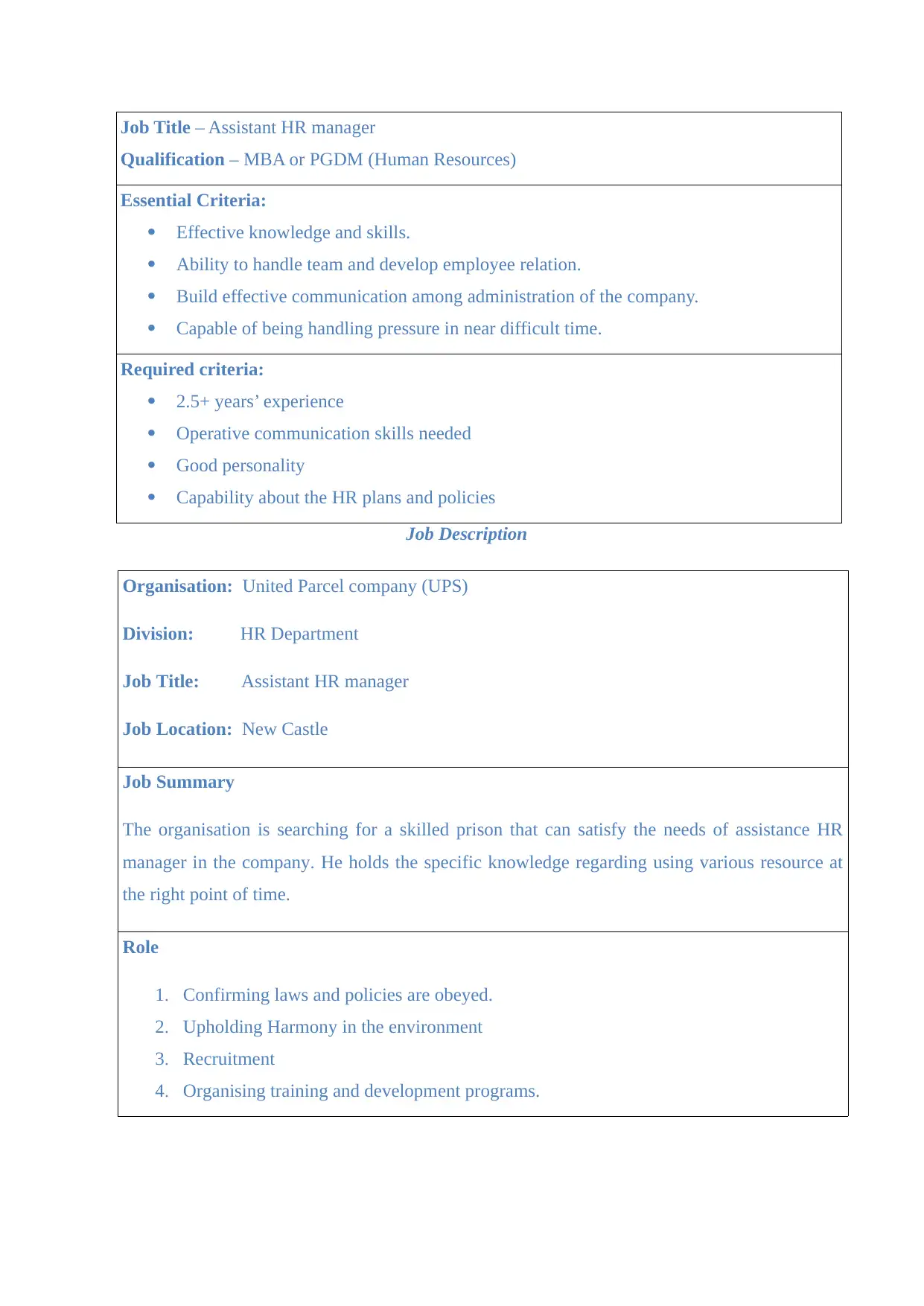
Job Title – Assistant HR manager
Qualification – MBA or PGDM (Human Resources)
Essential Criteria:
Effective knowledge and skills.
Ability to handle team and develop employee relation.
Build effective communication among administration of the company.
Capable of being handling pressure in near difficult time.
Required criteria:
2.5+ years’ experience
Operative communication skills needed
Good personality
Capability about the HR plans and policies
Job Description
Organisation: United Parcel company (UPS)
Division: HR Department
Job Title: Assistant HR manager
Job Location: New Castle
Job Summary
The organisation is searching for a skilled prison that can satisfy the needs of assistance HR
manager in the company. He holds the specific knowledge regarding using various resource at
the right point of time.
Role
1. Confirming laws and policies are obeyed.
2. Upholding Harmony in the environment
3. Recruitment
4. Organising training and development programs.
Qualification – MBA or PGDM (Human Resources)
Essential Criteria:
Effective knowledge and skills.
Ability to handle team and develop employee relation.
Build effective communication among administration of the company.
Capable of being handling pressure in near difficult time.
Required criteria:
2.5+ years’ experience
Operative communication skills needed
Good personality
Capability about the HR plans and policies
Job Description
Organisation: United Parcel company (UPS)
Division: HR Department
Job Title: Assistant HR manager
Job Location: New Castle
Job Summary
The organisation is searching for a skilled prison that can satisfy the needs of assistance HR
manager in the company. He holds the specific knowledge regarding using various resource at
the right point of time.
Role
1. Confirming laws and policies are obeyed.
2. Upholding Harmony in the environment
3. Recruitment
4. Organising training and development programs.
Secure Best Marks with AI Grader
Need help grading? Try our AI Grader for instant feedback on your assignments.

1.2 Impact of legal, regulatory and ethical factors on the recruitment and selection
process
An individual is having all sorts of desired ability for attaining an organisational aim
that are required to be chosen by an organisation. The process consists of same as selection
process. The candidates are needed to perform in the selection process as per the job position
which is offered by the company.
Minimum wages act: - This act has enforced by the government to secure the right of the
worker to sustain their better livelihood. So it must compulsory for the each and every industry to
provide the minimum wages as per the norms of the industry decided by the government
authority (Arnold, Fletcher and Molyneux, 2012).
Equal pay act 1970: - As per this act all the employee on the same position in the company
should provide same remuneration. Employer can’t impose any discrimination on the basis of
gender, caste, creed, complexion etc.
Health and safety law: - Top management are responsible for the provide healthy working
environment which has no adverse or harmful impact on the employee.
Maternity leave: - As per this law the company have to be given six months (180 days) of full
paid leave to female employee including all the benefits.
Workplace equality law: - This law passed to stop the discrimination on the basis of caste,
nationality, race, complexion, gender etc.
The equality act 2010: Under this particular law, it will be more considered as unlawful
in case any other discrimination has been made on ground of the age, race, gender and sex. A
high level of accuracy for the CV data has been given to the employer that they need through
applied people for the particular position.
So legal, regulatory and ethical factors influenced and bound United Parcel company (UPS)
company decision making process respect to the recruitment and selection.
1.3 HR manager role/participation in selection process: -
The human resource manager of United Parcel company (UPS) has play an important
role in selection process. The HR manager takes following steps these are:-
process
An individual is having all sorts of desired ability for attaining an organisational aim
that are required to be chosen by an organisation. The process consists of same as selection
process. The candidates are needed to perform in the selection process as per the job position
which is offered by the company.
Minimum wages act: - This act has enforced by the government to secure the right of the
worker to sustain their better livelihood. So it must compulsory for the each and every industry to
provide the minimum wages as per the norms of the industry decided by the government
authority (Arnold, Fletcher and Molyneux, 2012).
Equal pay act 1970: - As per this act all the employee on the same position in the company
should provide same remuneration. Employer can’t impose any discrimination on the basis of
gender, caste, creed, complexion etc.
Health and safety law: - Top management are responsible for the provide healthy working
environment which has no adverse or harmful impact on the employee.
Maternity leave: - As per this law the company have to be given six months (180 days) of full
paid leave to female employee including all the benefits.
Workplace equality law: - This law passed to stop the discrimination on the basis of caste,
nationality, race, complexion, gender etc.
The equality act 2010: Under this particular law, it will be more considered as unlawful
in case any other discrimination has been made on ground of the age, race, gender and sex. A
high level of accuracy for the CV data has been given to the employer that they need through
applied people for the particular position.
So legal, regulatory and ethical factors influenced and bound United Parcel company (UPS)
company decision making process respect to the recruitment and selection.
1.3 HR manager role/participation in selection process: -
The human resource manager of United Parcel company (UPS) has play an important
role in selection process. The HR manager takes following steps these are:-
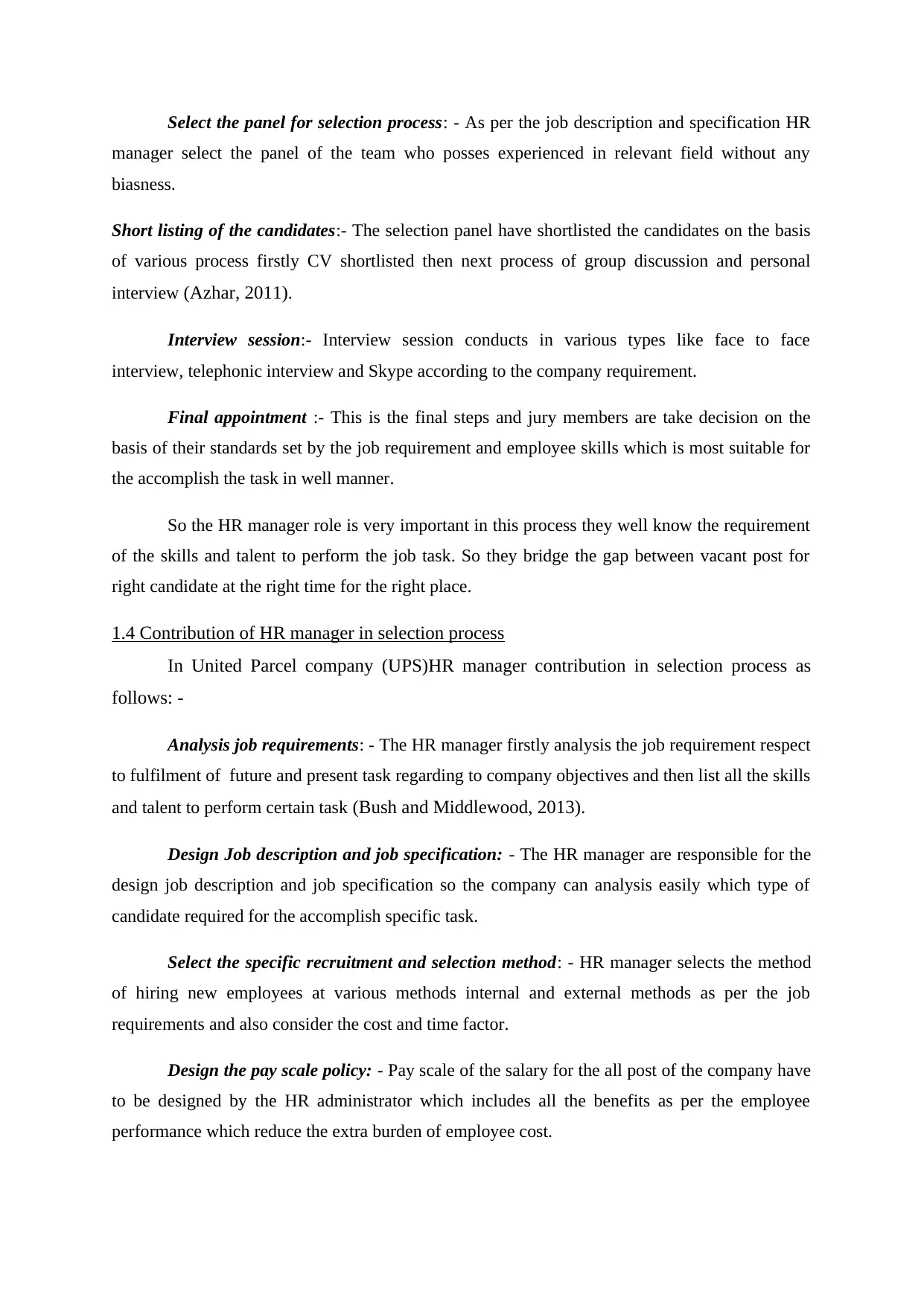
Select the panel for selection process: - As per the job description and specification HR
manager select the panel of the team who posses experienced in relevant field without any
biasness.
Short listing of the candidates:- The selection panel have shortlisted the candidates on the basis
of various process firstly CV shortlisted then next process of group discussion and personal
interview (Azhar, 2011).
Interview session:- Interview session conducts in various types like face to face
interview, telephonic interview and Skype according to the company requirement.
Final appointment :- This is the final steps and jury members are take decision on the
basis of their standards set by the job requirement and employee skills which is most suitable for
the accomplish the task in well manner.
So the HR manager role is very important in this process they well know the requirement
of the skills and talent to perform the job task. So they bridge the gap between vacant post for
right candidate at the right time for the right place.
1.4 Contribution of HR manager in selection process
In United Parcel company (UPS)HR manager contribution in selection process as
follows: -
Analysis job requirements: - The HR manager firstly analysis the job requirement respect
to fulfilment of future and present task regarding to company objectives and then list all the skills
and talent to perform certain task (Bush and Middlewood, 2013).
Design Job description and job specification: - The HR manager are responsible for the
design job description and job specification so the company can analysis easily which type of
candidate required for the accomplish specific task.
Select the specific recruitment and selection method: - HR manager selects the method
of hiring new employees at various methods internal and external methods as per the job
requirements and also consider the cost and time factor.
Design the pay scale policy: - Pay scale of the salary for the all post of the company have
to be designed by the HR administrator which includes all the benefits as per the employee
performance which reduce the extra burden of employee cost.
manager select the panel of the team who posses experienced in relevant field without any
biasness.
Short listing of the candidates:- The selection panel have shortlisted the candidates on the basis
of various process firstly CV shortlisted then next process of group discussion and personal
interview (Azhar, 2011).
Interview session:- Interview session conducts in various types like face to face
interview, telephonic interview and Skype according to the company requirement.
Final appointment :- This is the final steps and jury members are take decision on the
basis of their standards set by the job requirement and employee skills which is most suitable for
the accomplish the task in well manner.
So the HR manager role is very important in this process they well know the requirement
of the skills and talent to perform the job task. So they bridge the gap between vacant post for
right candidate at the right time for the right place.
1.4 Contribution of HR manager in selection process
In United Parcel company (UPS)HR manager contribution in selection process as
follows: -
Analysis job requirements: - The HR manager firstly analysis the job requirement respect
to fulfilment of future and present task regarding to company objectives and then list all the skills
and talent to perform certain task (Bush and Middlewood, 2013).
Design Job description and job specification: - The HR manager are responsible for the
design job description and job specification so the company can analysis easily which type of
candidate required for the accomplish specific task.
Select the specific recruitment and selection method: - HR manager selects the method
of hiring new employees at various methods internal and external methods as per the job
requirements and also consider the cost and time factor.
Design the pay scale policy: - Pay scale of the salary for the all post of the company have
to be designed by the HR administrator which includes all the benefits as per the employee
performance which reduce the extra burden of employee cost.
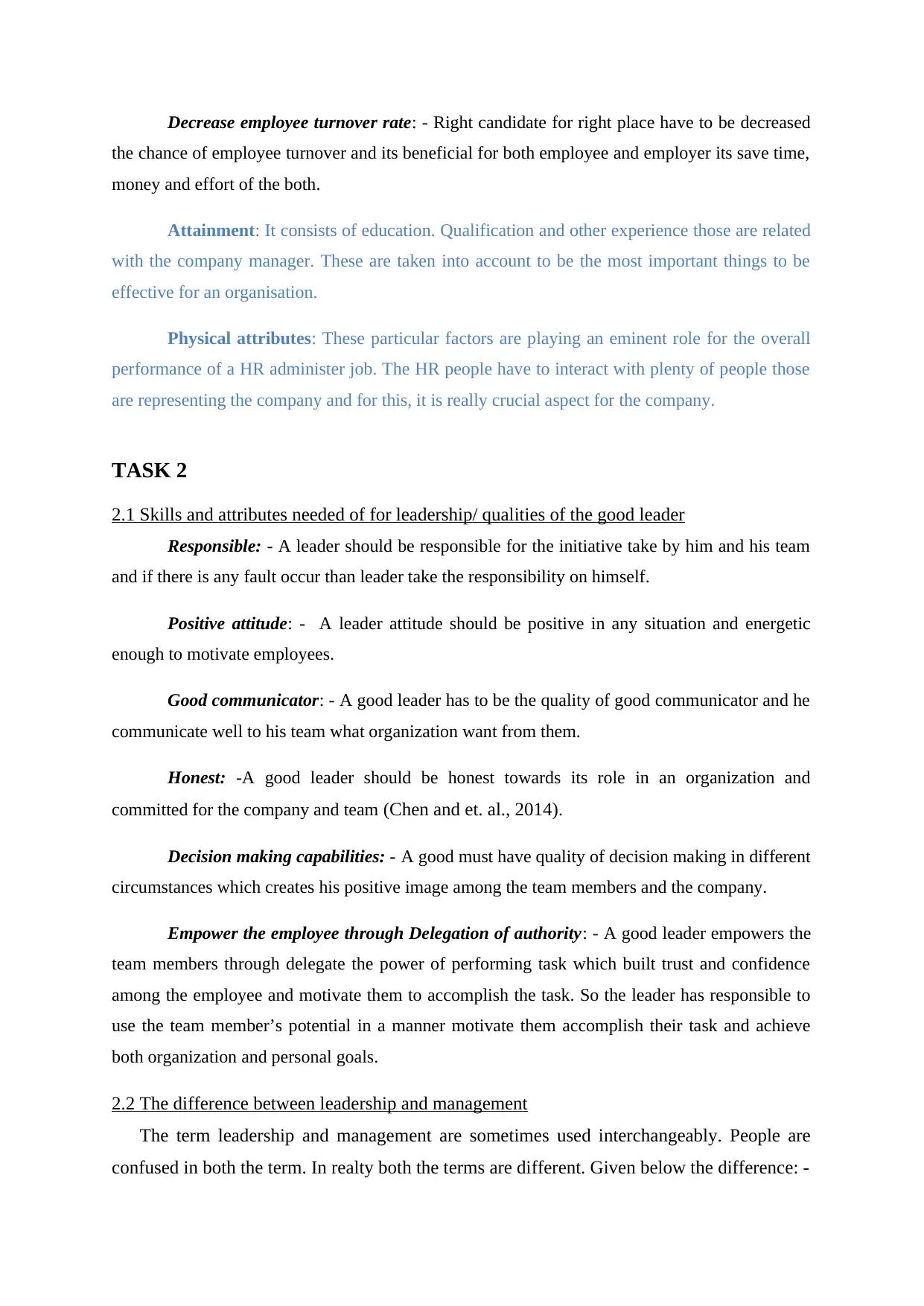
Decrease employee turnover rate: - Right candidate for right place have to be decreased
the chance of employee turnover and its beneficial for both employee and employer its save time,
money and effort of the both.
Attainment: It consists of education. Qualification and other experience those are related
with the company manager. These are taken into account to be the most important things to be
effective for an organisation.
Physical attributes: These particular factors are playing an eminent role for the overall
performance of a HR administer job. The HR people have to interact with plenty of people those
are representing the company and for this, it is really crucial aspect for the company.
TASK 2
2.1 Skills and attributes needed of for leadership/ qualities of the good leader
Responsible: - A leader should be responsible for the initiative take by him and his team
and if there is any fault occur than leader take the responsibility on himself.
Positive attitude: - A leader attitude should be positive in any situation and energetic
enough to motivate employees.
Good communicator: - A good leader has to be the quality of good communicator and he
communicate well to his team what organization want from them.
Honest: -A good leader should be honest towards its role in an organization and
committed for the company and team (Chen and et. al., 2014).
Decision making capabilities: - A good must have quality of decision making in different
circumstances which creates his positive image among the team members and the company.
Empower the employee through Delegation of authority: - A good leader empowers the
team members through delegate the power of performing task which built trust and confidence
among the employee and motivate them to accomplish the task. So the leader has responsible to
use the team member’s potential in a manner motivate them accomplish their task and achieve
both organization and personal goals.
2.2 The difference between leadership and management
The term leadership and management are sometimes used interchangeably. People are
confused in both the term. In realty both the terms are different. Given below the difference: -
the chance of employee turnover and its beneficial for both employee and employer its save time,
money and effort of the both.
Attainment: It consists of education. Qualification and other experience those are related
with the company manager. These are taken into account to be the most important things to be
effective for an organisation.
Physical attributes: These particular factors are playing an eminent role for the overall
performance of a HR administer job. The HR people have to interact with plenty of people those
are representing the company and for this, it is really crucial aspect for the company.
TASK 2
2.1 Skills and attributes needed of for leadership/ qualities of the good leader
Responsible: - A leader should be responsible for the initiative take by him and his team
and if there is any fault occur than leader take the responsibility on himself.
Positive attitude: - A leader attitude should be positive in any situation and energetic
enough to motivate employees.
Good communicator: - A good leader has to be the quality of good communicator and he
communicate well to his team what organization want from them.
Honest: -A good leader should be honest towards its role in an organization and
committed for the company and team (Chen and et. al., 2014).
Decision making capabilities: - A good must have quality of decision making in different
circumstances which creates his positive image among the team members and the company.
Empower the employee through Delegation of authority: - A good leader empowers the
team members through delegate the power of performing task which built trust and confidence
among the employee and motivate them to accomplish the task. So the leader has responsible to
use the team member’s potential in a manner motivate them accomplish their task and achieve
both organization and personal goals.
2.2 The difference between leadership and management
The term leadership and management are sometimes used interchangeably. People are
confused in both the term. In realty both the terms are different. Given below the difference: -
Paraphrase This Document
Need a fresh take? Get an instant paraphrase of this document with our AI Paraphraser
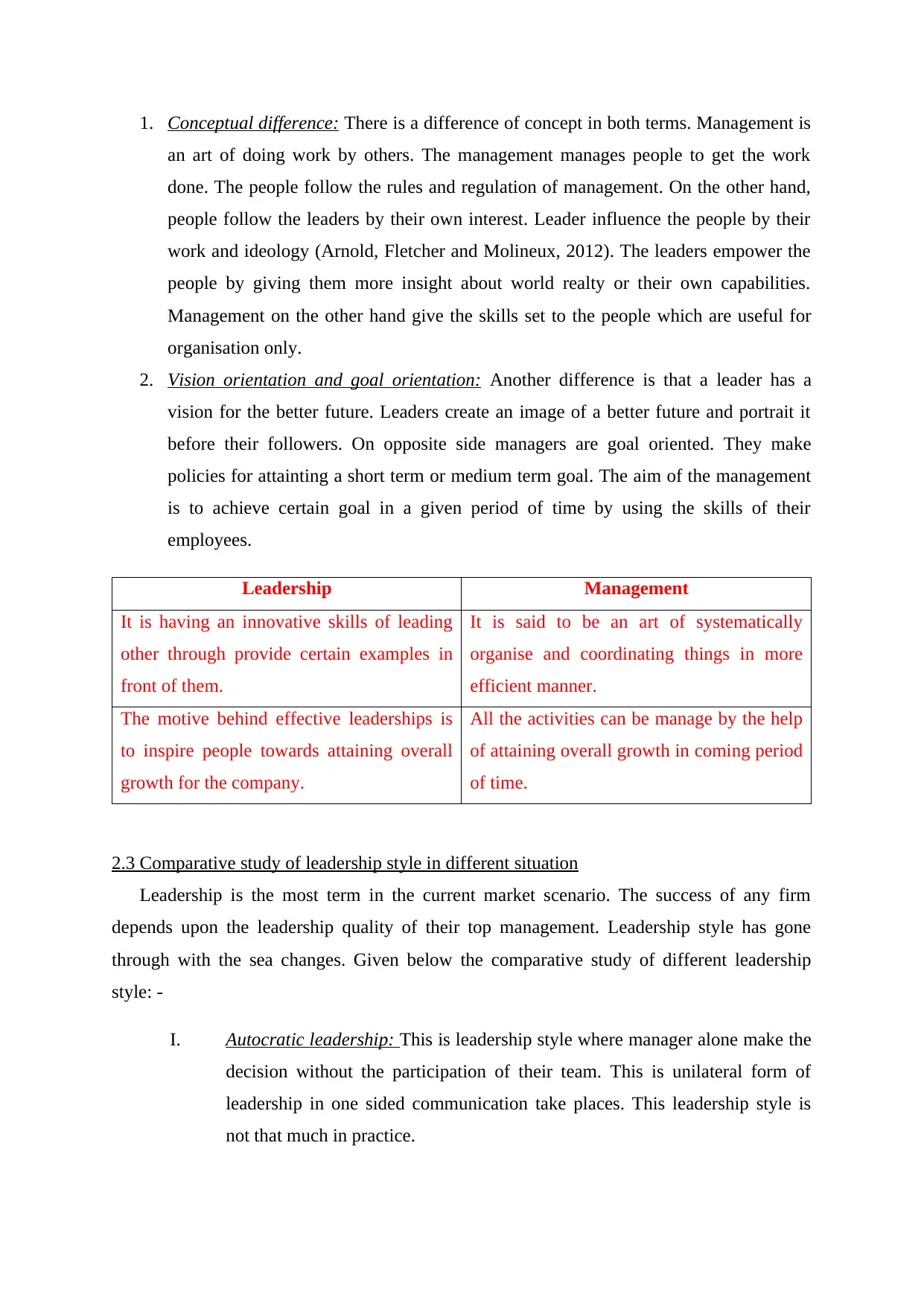
1. Conceptual difference: There is a difference of concept in both terms. Management is
an art of doing work by others. The management manages people to get the work
done. The people follow the rules and regulation of management. On the other hand,
people follow the leaders by their own interest. Leader influence the people by their
work and ideology (Arnold, Fletcher and Molineux, 2012). The leaders empower the
people by giving them more insight about world realty or their own capabilities.
Management on the other hand give the skills set to the people which are useful for
organisation only.
2. Vision orientation and goal orientation: Another difference is that a leader has a
vision for the better future. Leaders create an image of a better future and portrait it
before their followers. On opposite side managers are goal oriented. They make
policies for attainting a short term or medium term goal. The aim of the management
is to achieve certain goal in a given period of time by using the skills of their
employees.
Leadership Management
It is having an innovative skills of leading
other through provide certain examples in
front of them.
It is said to be an art of systematically
organise and coordinating things in more
efficient manner.
The motive behind effective leaderships is
to inspire people towards attaining overall
growth for the company.
All the activities can be manage by the help
of attaining overall growth in coming period
of time.
2.3 Comparative study of leadership style in different situation
Leadership is the most term in the current market scenario. The success of any firm
depends upon the leadership quality of their top management. Leadership style has gone
through with the sea changes. Given below the comparative study of different leadership
style: -
I. Autocratic leadership: This is leadership style where manager alone make the
decision without the participation of their team. This is unilateral form of
leadership in one sided communication take places. This leadership style is
not that much in practice.
an art of doing work by others. The management manages people to get the work
done. The people follow the rules and regulation of management. On the other hand,
people follow the leaders by their own interest. Leader influence the people by their
work and ideology (Arnold, Fletcher and Molineux, 2012). The leaders empower the
people by giving them more insight about world realty or their own capabilities.
Management on the other hand give the skills set to the people which are useful for
organisation only.
2. Vision orientation and goal orientation: Another difference is that a leader has a
vision for the better future. Leaders create an image of a better future and portrait it
before their followers. On opposite side managers are goal oriented. They make
policies for attainting a short term or medium term goal. The aim of the management
is to achieve certain goal in a given period of time by using the skills of their
employees.
Leadership Management
It is having an innovative skills of leading
other through provide certain examples in
front of them.
It is said to be an art of systematically
organise and coordinating things in more
efficient manner.
The motive behind effective leaderships is
to inspire people towards attaining overall
growth for the company.
All the activities can be manage by the help
of attaining overall growth in coming period
of time.
2.3 Comparative study of leadership style in different situation
Leadership is the most term in the current market scenario. The success of any firm
depends upon the leadership quality of their top management. Leadership style has gone
through with the sea changes. Given below the comparative study of different leadership
style: -
I. Autocratic leadership: This is leadership style where manager alone make the
decision without the participation of their team. This is unilateral form of
leadership in one sided communication take places. This leadership style is
not that much in practice.
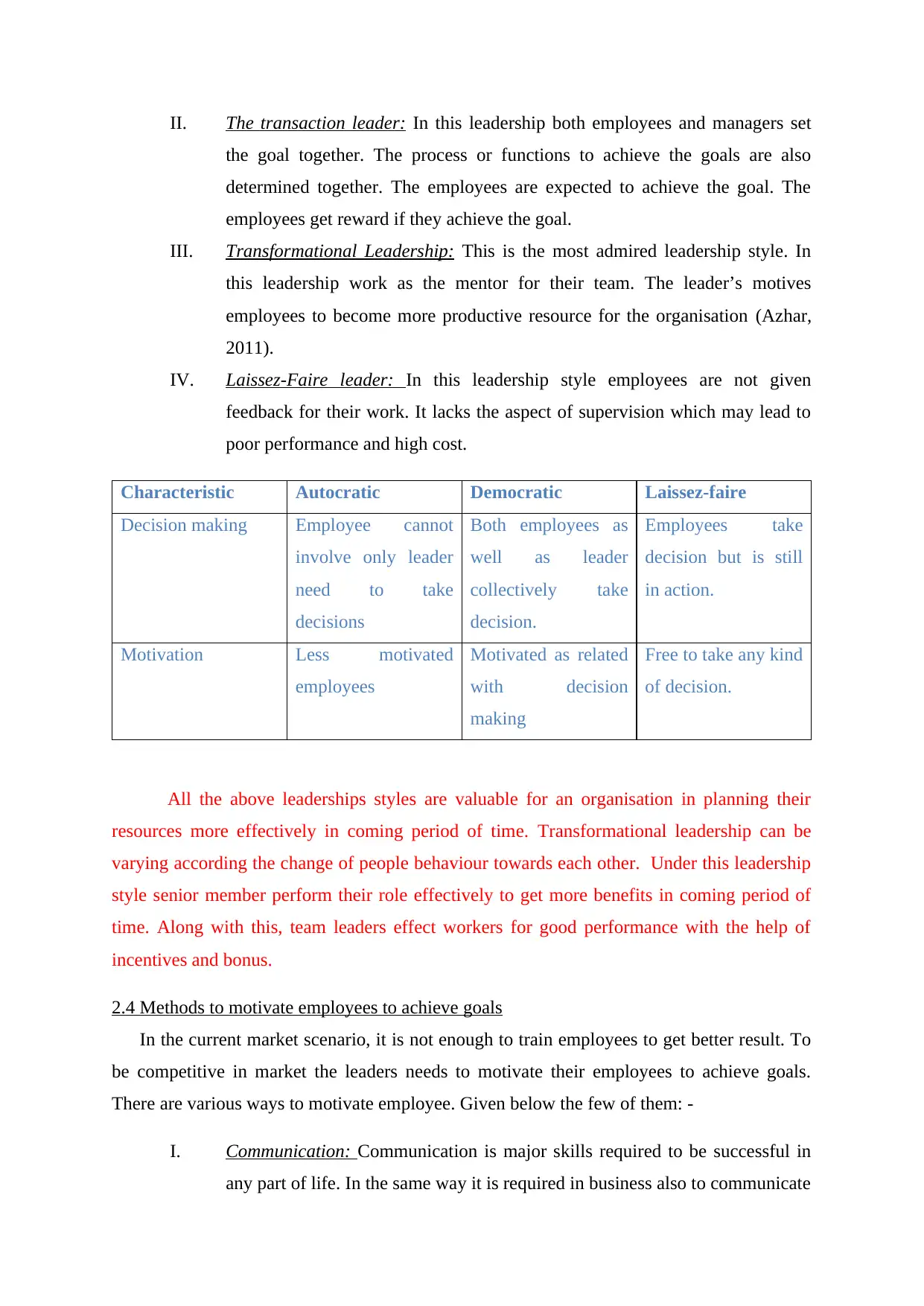
II. The transaction leader: In this leadership both employees and managers set
the goal together. The process or functions to achieve the goals are also
determined together. The employees are expected to achieve the goal. The
employees get reward if they achieve the goal.
III. Transformational Leadership: This is the most admired leadership style. In
this leadership work as the mentor for their team. The leader’s motives
employees to become more productive resource for the organisation (Azhar,
2011).
IV. Laissez-Faire leader: In this leadership style employees are not given
feedback for their work. It lacks the aspect of supervision which may lead to
poor performance and high cost.
Characteristic Autocratic Democratic Laissez-faire
Decision making Employee cannot
involve only leader
need to take
decisions
Both employees as
well as leader
collectively take
decision.
Employees take
decision but is still
in action.
Motivation Less motivated
employees
Motivated as related
with decision
making
Free to take any kind
of decision.
All the above leaderships styles are valuable for an organisation in planning their
resources more effectively in coming period of time. Transformational leadership can be
varying according the change of people behaviour towards each other. Under this leadership
style senior member perform their role effectively to get more benefits in coming period of
time. Along with this, team leaders effect workers for good performance with the help of
incentives and bonus.
2.4 Methods to motivate employees to achieve goals
In the current market scenario, it is not enough to train employees to get better result. To
be competitive in market the leaders needs to motivate their employees to achieve goals.
There are various ways to motivate employee. Given below the few of them: -
I. Communication: Communication is major skills required to be successful in
any part of life. In the same way it is required in business also to communicate
the goal together. The process or functions to achieve the goals are also
determined together. The employees are expected to achieve the goal. The
employees get reward if they achieve the goal.
III. Transformational Leadership: This is the most admired leadership style. In
this leadership work as the mentor for their team. The leader’s motives
employees to become more productive resource for the organisation (Azhar,
2011).
IV. Laissez-Faire leader: In this leadership style employees are not given
feedback for their work. It lacks the aspect of supervision which may lead to
poor performance and high cost.
Characteristic Autocratic Democratic Laissez-faire
Decision making Employee cannot
involve only leader
need to take
decisions
Both employees as
well as leader
collectively take
decision.
Employees take
decision but is still
in action.
Motivation Less motivated
employees
Motivated as related
with decision
making
Free to take any kind
of decision.
All the above leaderships styles are valuable for an organisation in planning their
resources more effectively in coming period of time. Transformational leadership can be
varying according the change of people behaviour towards each other. Under this leadership
style senior member perform their role effectively to get more benefits in coming period of
time. Along with this, team leaders effect workers for good performance with the help of
incentives and bonus.
2.4 Methods to motivate employees to achieve goals
In the current market scenario, it is not enough to train employees to get better result. To
be competitive in market the leaders needs to motivate their employees to achieve goals.
There are various ways to motivate employee. Given below the few of them: -
I. Communication: Communication is major skills required to be successful in
any part of life. In the same way it is required in business also to communicate
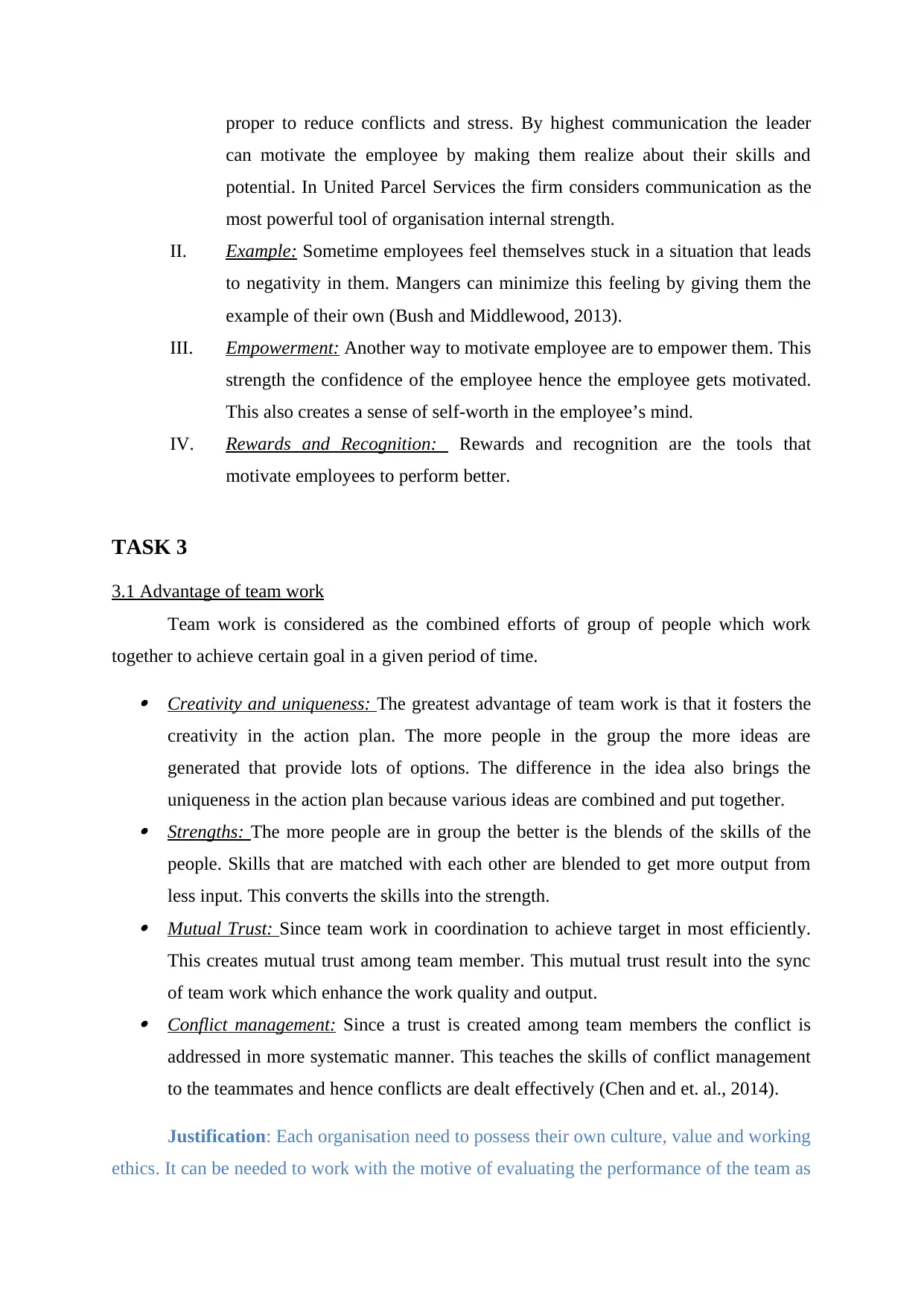
proper to reduce conflicts and stress. By highest communication the leader
can motivate the employee by making them realize about their skills and
potential. In United Parcel Services the firm considers communication as the
most powerful tool of organisation internal strength.
II. Example: Sometime employees feel themselves stuck in a situation that leads
to negativity in them. Mangers can minimize this feeling by giving them the
example of their own (Bush and Middlewood, 2013).
III. Empowerment: Another way to motivate employee are to empower them. This
strength the confidence of the employee hence the employee gets motivated.
This also creates a sense of self-worth in the employee’s mind.
IV. Rewards and Recognition: Rewards and recognition are the tools that
motivate employees to perform better.
TASK 3
3.1 Advantage of team work
Team work is considered as the combined efforts of group of people which work
together to achieve certain goal in a given period of time.
Creativity and uniqueness: The greatest advantage of team work is that it fosters the
creativity in the action plan. The more people in the group the more ideas are
generated that provide lots of options. The difference in the idea also brings the
uniqueness in the action plan because various ideas are combined and put together. Strengths: The more people are in group the better is the blends of the skills of the
people. Skills that are matched with each other are blended to get more output from
less input. This converts the skills into the strength. Mutual Trust: Since team work in coordination to achieve target in most efficiently.
This creates mutual trust among team member. This mutual trust result into the sync
of team work which enhance the work quality and output. Conflict management: Since a trust is created among team members the conflict is
addressed in more systematic manner. This teaches the skills of conflict management
to the teammates and hence conflicts are dealt effectively (Chen and et. al., 2014).
Justification: Each organisation need to possess their own culture, value and working
ethics. It can be needed to work with the motive of evaluating the performance of the team as
can motivate the employee by making them realize about their skills and
potential. In United Parcel Services the firm considers communication as the
most powerful tool of organisation internal strength.
II. Example: Sometime employees feel themselves stuck in a situation that leads
to negativity in them. Mangers can minimize this feeling by giving them the
example of their own (Bush and Middlewood, 2013).
III. Empowerment: Another way to motivate employee are to empower them. This
strength the confidence of the employee hence the employee gets motivated.
This also creates a sense of self-worth in the employee’s mind.
IV. Rewards and Recognition: Rewards and recognition are the tools that
motivate employees to perform better.
TASK 3
3.1 Advantage of team work
Team work is considered as the combined efforts of group of people which work
together to achieve certain goal in a given period of time.
Creativity and uniqueness: The greatest advantage of team work is that it fosters the
creativity in the action plan. The more people in the group the more ideas are
generated that provide lots of options. The difference in the idea also brings the
uniqueness in the action plan because various ideas are combined and put together. Strengths: The more people are in group the better is the blends of the skills of the
people. Skills that are matched with each other are blended to get more output from
less input. This converts the skills into the strength. Mutual Trust: Since team work in coordination to achieve target in most efficiently.
This creates mutual trust among team member. This mutual trust result into the sync
of team work which enhance the work quality and output. Conflict management: Since a trust is created among team members the conflict is
addressed in more systematic manner. This teaches the skills of conflict management
to the teammates and hence conflicts are dealt effectively (Chen and et. al., 2014).
Justification: Each organisation need to possess their own culture, value and working
ethics. It can be needed to work with the motive of evaluating the performance of the team as
Secure Best Marks with AI Grader
Need help grading? Try our AI Grader for instant feedback on your assignments.
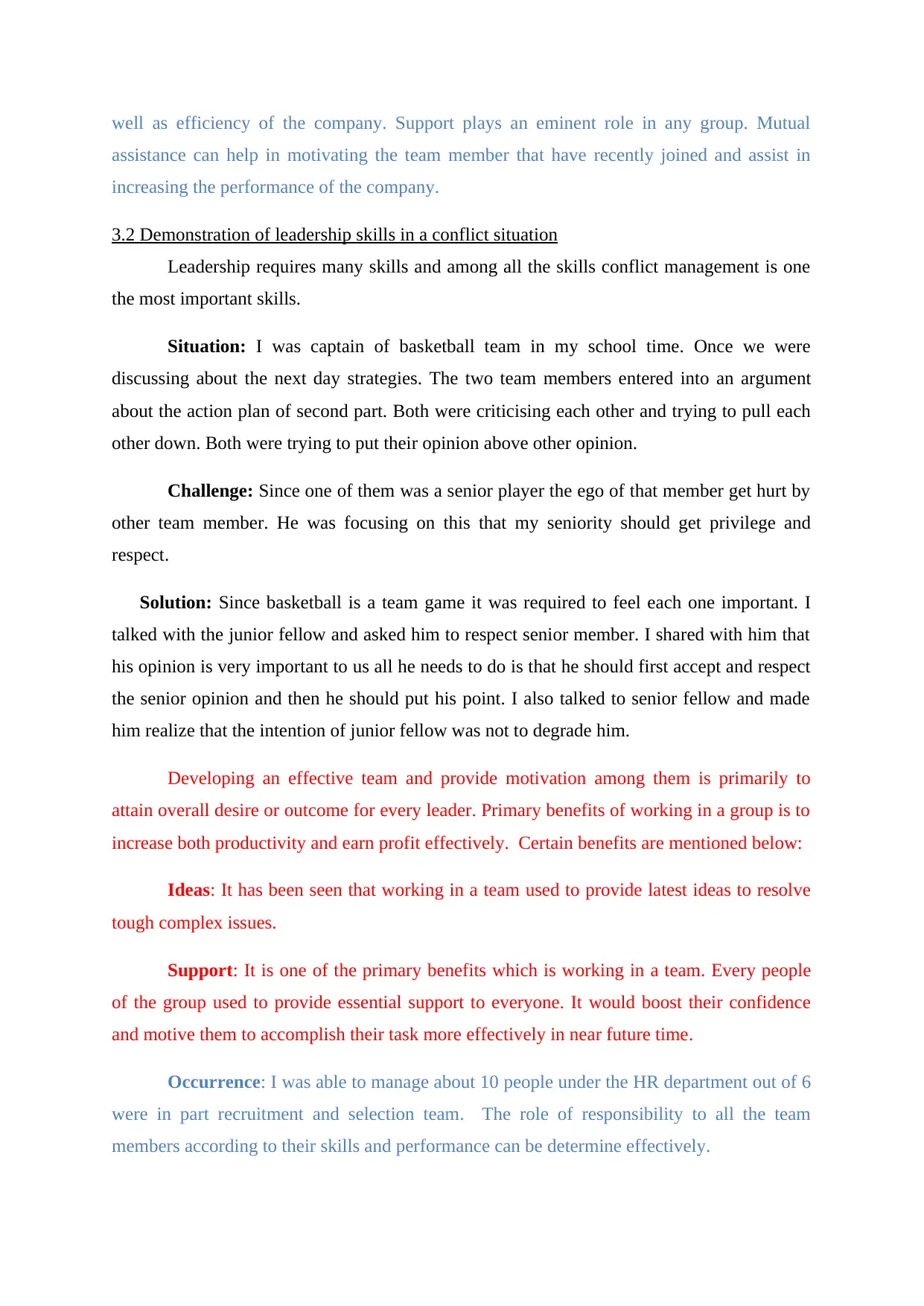
well as efficiency of the company. Support plays an eminent role in any group. Mutual
assistance can help in motivating the team member that have recently joined and assist in
increasing the performance of the company.
3.2 Demonstration of leadership skills in a conflict situation
Leadership requires many skills and among all the skills conflict management is one
the most important skills.
Situation: I was captain of basketball team in my school time. Once we were
discussing about the next day strategies. The two team members entered into an argument
about the action plan of second part. Both were criticising each other and trying to pull each
other down. Both were trying to put their opinion above other opinion.
Challenge: Since one of them was a senior player the ego of that member get hurt by
other team member. He was focusing on this that my seniority should get privilege and
respect.
Solution: Since basketball is a team game it was required to feel each one important. I
talked with the junior fellow and asked him to respect senior member. I shared with him that
his opinion is very important to us all he needs to do is that he should first accept and respect
the senior opinion and then he should put his point. I also talked to senior fellow and made
him realize that the intention of junior fellow was not to degrade him.
Developing an effective team and provide motivation among them is primarily to
attain overall desire or outcome for every leader. Primary benefits of working in a group is to
increase both productivity and earn profit effectively. Certain benefits are mentioned below:
Ideas: It has been seen that working in a team used to provide latest ideas to resolve
tough complex issues.
Support: It is one of the primary benefits which is working in a team. Every people
of the group used to provide essential support to everyone. It would boost their confidence
and motive them to accomplish their task more effectively in near future time.
Occurrence: I was able to manage about 10 people under the HR department out of 6
were in part recruitment and selection team. The role of responsibility to all the team
members according to their skills and performance can be determine effectively.
assistance can help in motivating the team member that have recently joined and assist in
increasing the performance of the company.
3.2 Demonstration of leadership skills in a conflict situation
Leadership requires many skills and among all the skills conflict management is one
the most important skills.
Situation: I was captain of basketball team in my school time. Once we were
discussing about the next day strategies. The two team members entered into an argument
about the action plan of second part. Both were criticising each other and trying to pull each
other down. Both were trying to put their opinion above other opinion.
Challenge: Since one of them was a senior player the ego of that member get hurt by
other team member. He was focusing on this that my seniority should get privilege and
respect.
Solution: Since basketball is a team game it was required to feel each one important. I
talked with the junior fellow and asked him to respect senior member. I shared with him that
his opinion is very important to us all he needs to do is that he should first accept and respect
the senior opinion and then he should put his point. I also talked to senior fellow and made
him realize that the intention of junior fellow was not to degrade him.
Developing an effective team and provide motivation among them is primarily to
attain overall desire or outcome for every leader. Primary benefits of working in a group is to
increase both productivity and earn profit effectively. Certain benefits are mentioned below:
Ideas: It has been seen that working in a team used to provide latest ideas to resolve
tough complex issues.
Support: It is one of the primary benefits which is working in a team. Every people
of the group used to provide essential support to everyone. It would boost their confidence
and motive them to accomplish their task more effectively in near future time.
Occurrence: I was able to manage about 10 people under the HR department out of 6
were in part recruitment and selection team. The role of responsibility to all the team
members according to their skills and performance can be determine effectively.
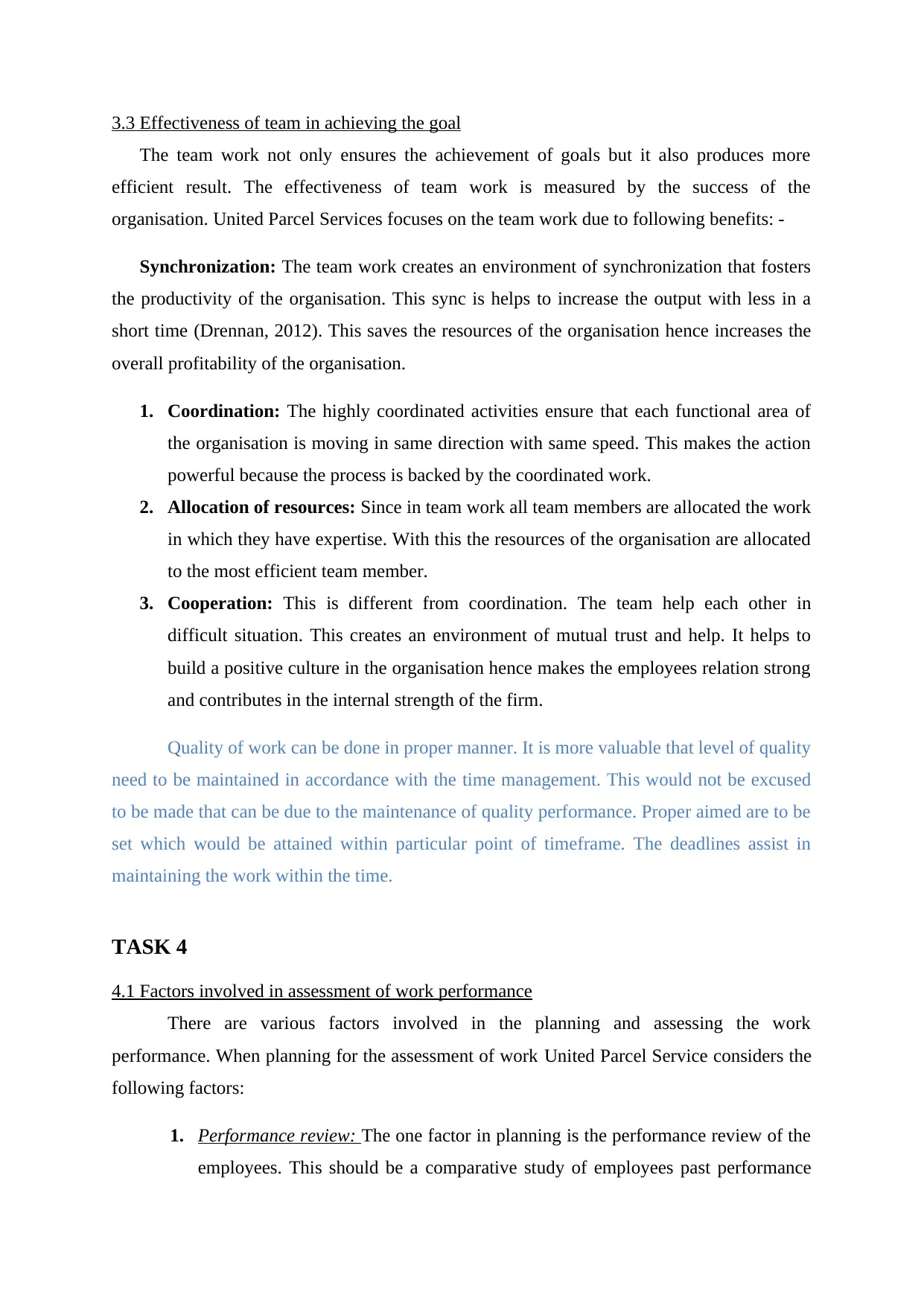
3.3 Effectiveness of team in achieving the goal
The team work not only ensures the achievement of goals but it also produces more
efficient result. The effectiveness of team work is measured by the success of the
organisation. United Parcel Services focuses on the team work due to following benefits: -
Synchronization: The team work creates an environment of synchronization that fosters
the productivity of the organisation. This sync is helps to increase the output with less in a
short time (Drennan, 2012). This saves the resources of the organisation hence increases the
overall profitability of the organisation.
1. Coordination: The highly coordinated activities ensure that each functional area of
the organisation is moving in same direction with same speed. This makes the action
powerful because the process is backed by the coordinated work.
2. Allocation of resources: Since in team work all team members are allocated the work
in which they have expertise. With this the resources of the organisation are allocated
to the most efficient team member.
3. Cooperation: This is different from coordination. The team help each other in
difficult situation. This creates an environment of mutual trust and help. It helps to
build a positive culture in the organisation hence makes the employees relation strong
and contributes in the internal strength of the firm.
Quality of work can be done in proper manner. It is more valuable that level of quality
need to be maintained in accordance with the time management. This would not be excused
to be made that can be due to the maintenance of quality performance. Proper aimed are to be
set which would be attained within particular point of timeframe. The deadlines assist in
maintaining the work within the time.
TASK 4
4.1 Factors involved in assessment of work performance
There are various factors involved in the planning and assessing the work
performance. When planning for the assessment of work United Parcel Service considers the
following factors:
1. Performance review: The one factor in planning is the performance review of the
employees. This should be a comparative study of employees past performance
The team work not only ensures the achievement of goals but it also produces more
efficient result. The effectiveness of team work is measured by the success of the
organisation. United Parcel Services focuses on the team work due to following benefits: -
Synchronization: The team work creates an environment of synchronization that fosters
the productivity of the organisation. This sync is helps to increase the output with less in a
short time (Drennan, 2012). This saves the resources of the organisation hence increases the
overall profitability of the organisation.
1. Coordination: The highly coordinated activities ensure that each functional area of
the organisation is moving in same direction with same speed. This makes the action
powerful because the process is backed by the coordinated work.
2. Allocation of resources: Since in team work all team members are allocated the work
in which they have expertise. With this the resources of the organisation are allocated
to the most efficient team member.
3. Cooperation: This is different from coordination. The team help each other in
difficult situation. This creates an environment of mutual trust and help. It helps to
build a positive culture in the organisation hence makes the employees relation strong
and contributes in the internal strength of the firm.
Quality of work can be done in proper manner. It is more valuable that level of quality
need to be maintained in accordance with the time management. This would not be excused
to be made that can be due to the maintenance of quality performance. Proper aimed are to be
set which would be attained within particular point of timeframe. The deadlines assist in
maintaining the work within the time.
TASK 4
4.1 Factors involved in assessment of work performance
There are various factors involved in the planning and assessing the work
performance. When planning for the assessment of work United Parcel Service considers the
following factors:
1. Performance review: The one factor in planning is the performance review of the
employees. This should be a comparative study of employees past performance
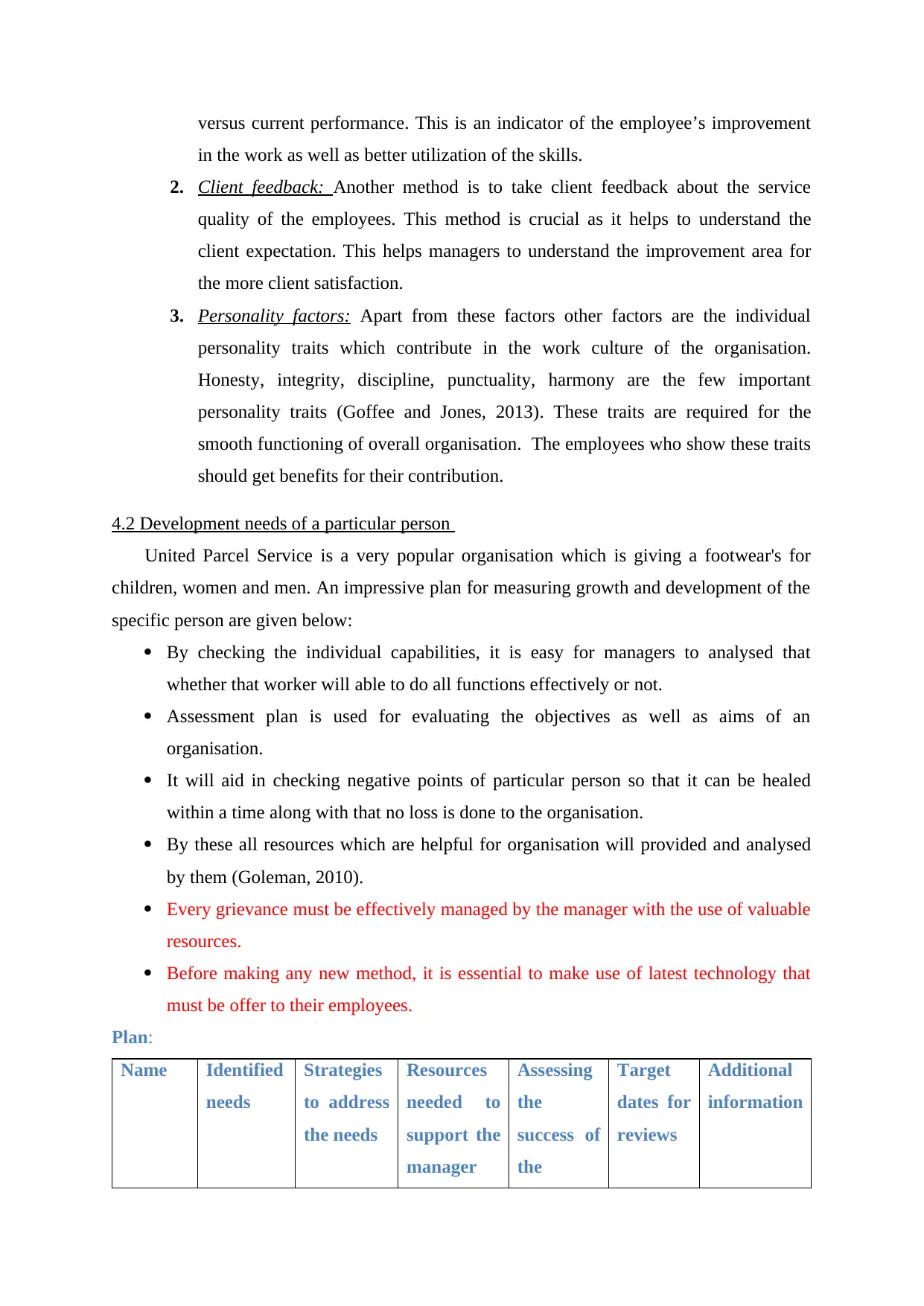
versus current performance. This is an indicator of the employee’s improvement
in the work as well as better utilization of the skills.
2. Client feedback: Another method is to take client feedback about the service
quality of the employees. This method is crucial as it helps to understand the
client expectation. This helps managers to understand the improvement area for
the more client satisfaction.
3. Personality factors: Apart from these factors other factors are the individual
personality traits which contribute in the work culture of the organisation.
Honesty, integrity, discipline, punctuality, harmony are the few important
personality traits (Goffee and Jones, 2013). These traits are required for the
smooth functioning of overall organisation. The employees who show these traits
should get benefits for their contribution.
4.2 Development needs of a particular person
United Parcel Service is a very popular organisation which is giving a footwear's for
children, women and men. An impressive plan for measuring growth and development of the
specific person are given below:
By checking the individual capabilities, it is easy for managers to analysed that
whether that worker will able to do all functions effectively or not.
Assessment plan is used for evaluating the objectives as well as aims of an
organisation.
It will aid in checking negative points of particular person so that it can be healed
within a time along with that no loss is done to the organisation.
By these all resources which are helpful for organisation will provided and analysed
by them (Goleman, 2010).
Every grievance must be effectively managed by the manager with the use of valuable
resources.
Before making any new method, it is essential to make use of latest technology that
must be offer to their employees.
Plan:
Name Identified
needs
Strategies
to address
the needs
Resources
needed to
support the
manager
Assessing
the
success of
the
Target
dates for
reviews
Additional
information
in the work as well as better utilization of the skills.
2. Client feedback: Another method is to take client feedback about the service
quality of the employees. This method is crucial as it helps to understand the
client expectation. This helps managers to understand the improvement area for
the more client satisfaction.
3. Personality factors: Apart from these factors other factors are the individual
personality traits which contribute in the work culture of the organisation.
Honesty, integrity, discipline, punctuality, harmony are the few important
personality traits (Goffee and Jones, 2013). These traits are required for the
smooth functioning of overall organisation. The employees who show these traits
should get benefits for their contribution.
4.2 Development needs of a particular person
United Parcel Service is a very popular organisation which is giving a footwear's for
children, women and men. An impressive plan for measuring growth and development of the
specific person are given below:
By checking the individual capabilities, it is easy for managers to analysed that
whether that worker will able to do all functions effectively or not.
Assessment plan is used for evaluating the objectives as well as aims of an
organisation.
It will aid in checking negative points of particular person so that it can be healed
within a time along with that no loss is done to the organisation.
By these all resources which are helpful for organisation will provided and analysed
by them (Goleman, 2010).
Every grievance must be effectively managed by the manager with the use of valuable
resources.
Before making any new method, it is essential to make use of latest technology that
must be offer to their employees.
Plan:
Name Identified
needs
Strategies
to address
the needs
Resources
needed to
support the
manager
Assessing
the
success of
the
Target
dates for
reviews
Additional
information
Paraphrase This Document
Need a fresh take? Get an instant paraphrase of this document with our AI Paraphraser
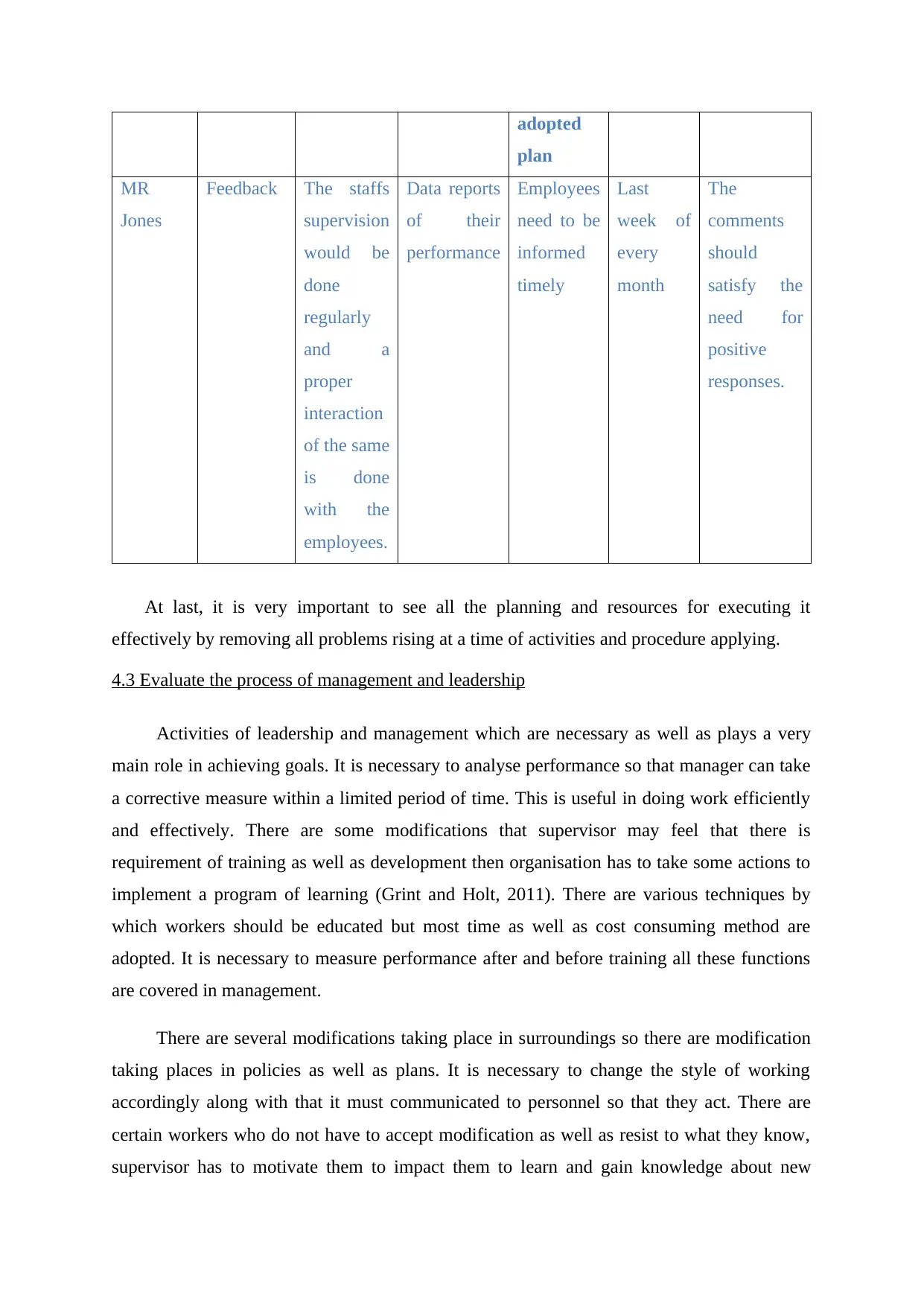
adopted
plan
MR
Jones
Feedback The staffs
supervision
would be
done
regularly
and a
proper
interaction
of the same
is done
with the
employees.
Data reports
of their
performance
Employees
need to be
informed
timely
Last
week of
every
month
The
comments
should
satisfy the
need for
positive
responses.
At last, it is very important to see all the planning and resources for executing it
effectively by removing all problems rising at a time of activities and procedure applying.
4.3 Evaluate the process of management and leadership
Activities of leadership and management which are necessary as well as plays a very
main role in achieving goals. It is necessary to analyse performance so that manager can take
a corrective measure within a limited period of time. This is useful in doing work efficiently
and effectively. There are some modifications that supervisor may feel that there is
requirement of training as well as development then organisation has to take some actions to
implement a program of learning (Grint and Holt, 2011). There are various techniques by
which workers should be educated but most time as well as cost consuming method are
adopted. It is necessary to measure performance after and before training all these functions
are covered in management.
There are several modifications taking place in surroundings so there are modification
taking places in policies as well as plans. It is necessary to change the style of working
accordingly along with that it must communicated to personnel so that they act. There are
certain workers who do not have to accept modification as well as resist to what they know,
supervisor has to motivate them to impact them to learn and gain knowledge about new
plan
MR
Jones
Feedback The staffs
supervision
would be
done
regularly
and a
proper
interaction
of the same
is done
with the
employees.
Data reports
of their
performance
Employees
need to be
informed
timely
Last
week of
every
month
The
comments
should
satisfy the
need for
positive
responses.
At last, it is very important to see all the planning and resources for executing it
effectively by removing all problems rising at a time of activities and procedure applying.
4.3 Evaluate the process of management and leadership
Activities of leadership and management which are necessary as well as plays a very
main role in achieving goals. It is necessary to analyse performance so that manager can take
a corrective measure within a limited period of time. This is useful in doing work efficiently
and effectively. There are some modifications that supervisor may feel that there is
requirement of training as well as development then organisation has to take some actions to
implement a program of learning (Grint and Holt, 2011). There are various techniques by
which workers should be educated but most time as well as cost consuming method are
adopted. It is necessary to measure performance after and before training all these functions
are covered in management.
There are several modifications taking place in surroundings so there are modification
taking places in policies as well as plans. It is necessary to change the style of working
accordingly along with that it must communicated to personnel so that they act. There are
certain workers who do not have to accept modification as well as resist to what they know,
supervisor has to motivate them to impact them to learn and gain knowledge about new
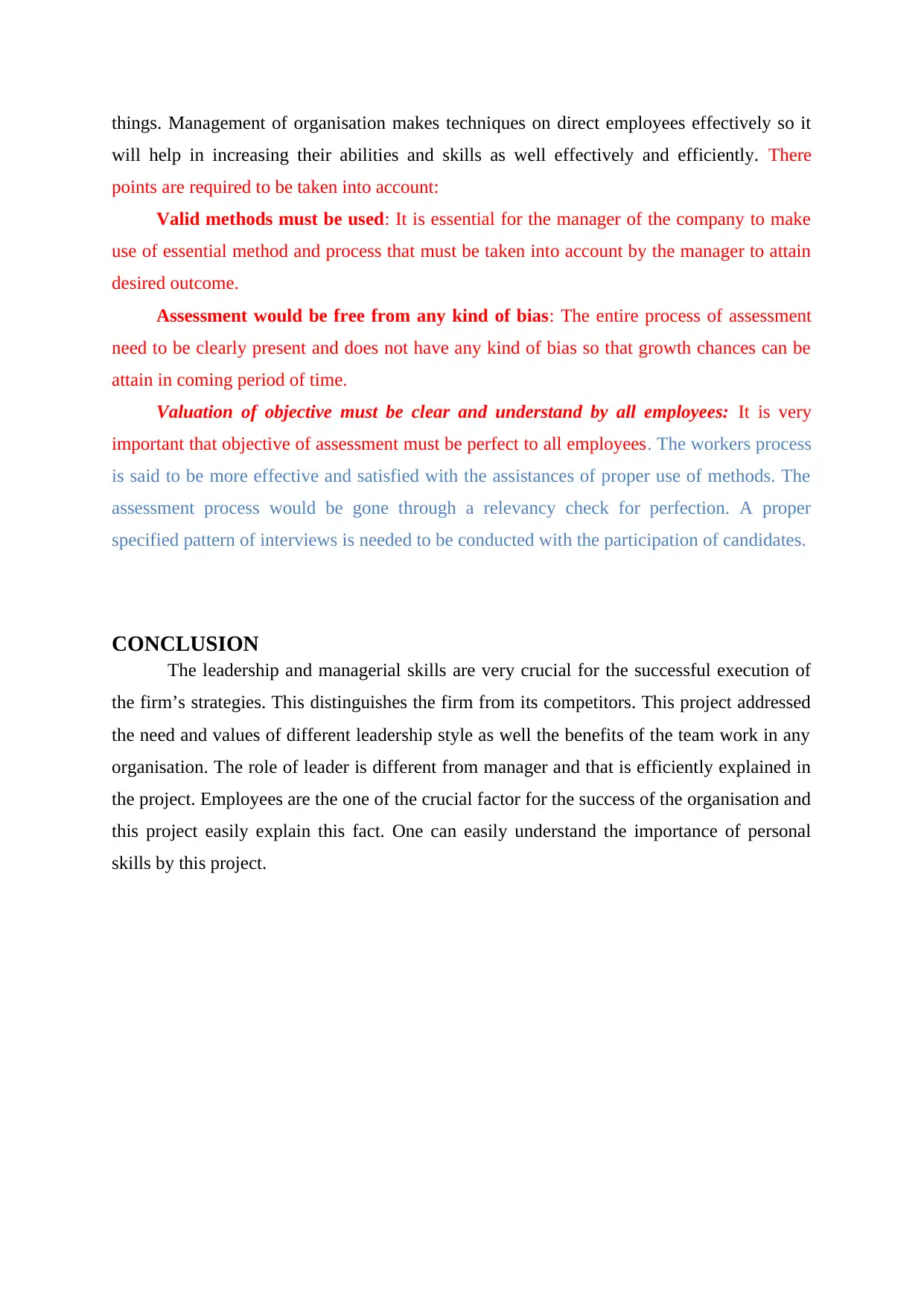
things. Management of organisation makes techniques on direct employees effectively so it
will help in increasing their abilities and skills as well effectively and efficiently. There
points are required to be taken into account:
Valid methods must be used: It is essential for the manager of the company to make
use of essential method and process that must be taken into account by the manager to attain
desired outcome.
Assessment would be free from any kind of bias: The entire process of assessment
need to be clearly present and does not have any kind of bias so that growth chances can be
attain in coming period of time.
Valuation of objective must be clear and understand by all employees: It is very
important that objective of assessment must be perfect to all employees. The workers process
is said to be more effective and satisfied with the assistances of proper use of methods. The
assessment process would be gone through a relevancy check for perfection. A proper
specified pattern of interviews is needed to be conducted with the participation of candidates.
CONCLUSION
The leadership and managerial skills are very crucial for the successful execution of
the firm’s strategies. This distinguishes the firm from its competitors. This project addressed
the need and values of different leadership style as well the benefits of the team work in any
organisation. The role of leader is different from manager and that is efficiently explained in
the project. Employees are the one of the crucial factor for the success of the organisation and
this project easily explain this fact. One can easily understand the importance of personal
skills by this project.
will help in increasing their abilities and skills as well effectively and efficiently. There
points are required to be taken into account:
Valid methods must be used: It is essential for the manager of the company to make
use of essential method and process that must be taken into account by the manager to attain
desired outcome.
Assessment would be free from any kind of bias: The entire process of assessment
need to be clearly present and does not have any kind of bias so that growth chances can be
attain in coming period of time.
Valuation of objective must be clear and understand by all employees: It is very
important that objective of assessment must be perfect to all employees. The workers process
is said to be more effective and satisfied with the assistances of proper use of methods. The
assessment process would be gone through a relevancy check for perfection. A proper
specified pattern of interviews is needed to be conducted with the participation of candidates.
CONCLUSION
The leadership and managerial skills are very crucial for the successful execution of
the firm’s strategies. This distinguishes the firm from its competitors. This project addressed
the need and values of different leadership style as well the benefits of the team work in any
organisation. The role of leader is different from manager and that is efficiently explained in
the project. Employees are the one of the crucial factor for the success of the organisation and
this project easily explain this fact. One can easily understand the importance of personal
skills by this project.

Secure Best Marks with AI Grader
Need help grading? Try our AI Grader for instant feedback on your assignments.

REFERENCES
Books and Journals
Alloway, T.P., Bibile, V. and Lau, G., 2013. Computerized working memory training: Can it
lead to gains in cognitive skills in students?. Computers in Human Behavior.
29(3). pp.632-638.
Arnold, R., Fletcher, D. and Molyneux, L., 2012. Performance leadership and management in
elite sport: recommendations, advice and suggestions from national performance
directors. European sport management quarterly. 12(4). pp.317-336.
Azhar, S., 2011. Building information modeling (BIM): Trends, benefits, risks, and
challenges for the AEC industry. Leadership and management in
engineering. 11(3). pp.241-252.
Bush, T and Middlewood, D., 2013. Leading and managing people in education. Sage.
Chen, L.K and et. al., 2014. Sarcopenia in Asia: consensus report of the Asian Working
Group for Sarcopenia. Journal of the American Medical Directors
Association.15(2). pp.95-101.
Drennan, J., 2012. Masters in nursing degrees: an evaluation of management and leadership
outcomes using a retrospective pre‐test design. Journal of nursing
management. 20(1). pp.102-112.
Goffee, R and Jones, G., 2013. Clever: Leading your smartest, most creative people. Harvard
Business Press.
Goleman, D., 2010. Why leading sustainability matters more than ever. People & Strategy.
33(1). pp.7-9.
Grint, K and Holt, C., 2011. Leading questions: If ‘Total Place’,‘Big Society’and local
leadership are the answers: What’s the question?. Leadership. 7(1). pp.85-98.
Hallinger, P. and Bryant, D., 2013. Mapping the terrain of educational leadership and
management in East Asia. Journal of Educational Administration. 51(5). pp.618-
637.
Books and Journals
Alloway, T.P., Bibile, V. and Lau, G., 2013. Computerized working memory training: Can it
lead to gains in cognitive skills in students?. Computers in Human Behavior.
29(3). pp.632-638.
Arnold, R., Fletcher, D. and Molyneux, L., 2012. Performance leadership and management in
elite sport: recommendations, advice and suggestions from national performance
directors. European sport management quarterly. 12(4). pp.317-336.
Azhar, S., 2011. Building information modeling (BIM): Trends, benefits, risks, and
challenges for the AEC industry. Leadership and management in
engineering. 11(3). pp.241-252.
Bush, T and Middlewood, D., 2013. Leading and managing people in education. Sage.
Chen, L.K and et. al., 2014. Sarcopenia in Asia: consensus report of the Asian Working
Group for Sarcopenia. Journal of the American Medical Directors
Association.15(2). pp.95-101.
Drennan, J., 2012. Masters in nursing degrees: an evaluation of management and leadership
outcomes using a retrospective pre‐test design. Journal of nursing
management. 20(1). pp.102-112.
Goffee, R and Jones, G., 2013. Clever: Leading your smartest, most creative people. Harvard
Business Press.
Goleman, D., 2010. Why leading sustainability matters more than ever. People & Strategy.
33(1). pp.7-9.
Grint, K and Holt, C., 2011. Leading questions: If ‘Total Place’,‘Big Society’and local
leadership are the answers: What’s the question?. Leadership. 7(1). pp.85-98.
Hallinger, P. and Bryant, D., 2013. Mapping the terrain of educational leadership and
management in East Asia. Journal of Educational Administration. 51(5). pp.618-
637.
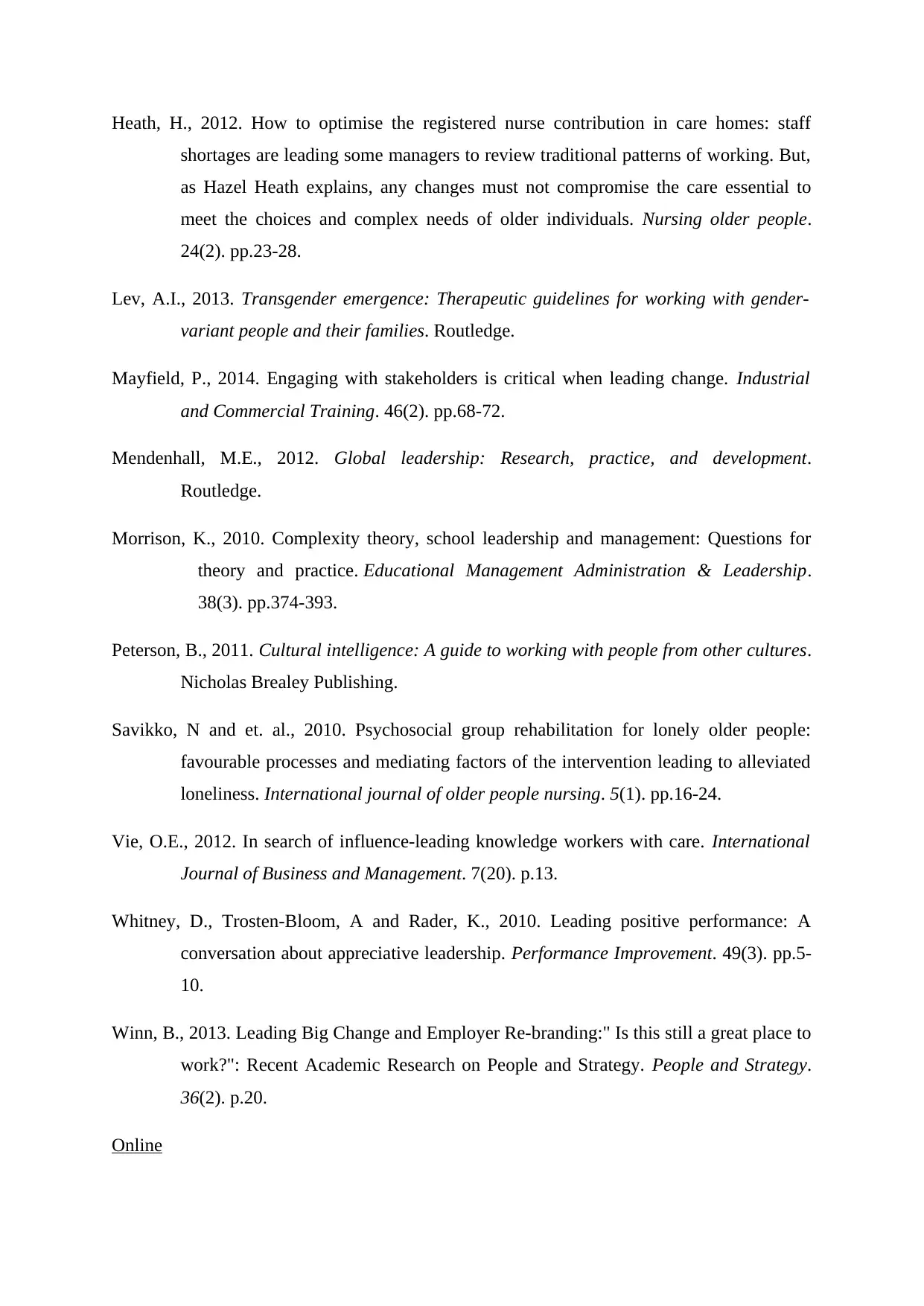
Heath, H., 2012. How to optimise the registered nurse contribution in care homes: staff
shortages are leading some managers to review traditional patterns of working. But,
as Hazel Heath explains, any changes must not compromise the care essential to
meet the choices and complex needs of older individuals. Nursing older people.
24(2). pp.23-28.
Lev, A.I., 2013. Transgender emergence: Therapeutic guidelines for working with gender-
variant people and their families. Routledge.
Mayfield, P., 2014. Engaging with stakeholders is critical when leading change. Industrial
and Commercial Training. 46(2). pp.68-72.
Mendenhall, M.E., 2012. Global leadership: Research, practice, and development.
Routledge.
Morrison, K., 2010. Complexity theory, school leadership and management: Questions for
theory and practice. Educational Management Administration & Leadership.
38(3). pp.374-393.
Peterson, B., 2011. Cultural intelligence: A guide to working with people from other cultures.
Nicholas Brealey Publishing.
Savikko, N and et. al., 2010. Psychosocial group rehabilitation for lonely older people:
favourable processes and mediating factors of the intervention leading to alleviated
loneliness. International journal of older people nursing. 5(1). pp.16-24.
Vie, O.E., 2012. In search of influence-leading knowledge workers with care. International
Journal of Business and Management. 7(20). p.13.
Whitney, D., Trosten‐Bloom, A and Rader, K., 2010. Leading positive performance: A
conversation about appreciative leadership. Performance Improvement. 49(3). pp.5-
10.
Winn, B., 2013. Leading Big Change and Employer Re-branding:" Is this still a great place to
work?": Recent Academic Research on People and Strategy. People and Strategy.
36(2). p.20.
Online
shortages are leading some managers to review traditional patterns of working. But,
as Hazel Heath explains, any changes must not compromise the care essential to
meet the choices and complex needs of older individuals. Nursing older people.
24(2). pp.23-28.
Lev, A.I., 2013. Transgender emergence: Therapeutic guidelines for working with gender-
variant people and their families. Routledge.
Mayfield, P., 2014. Engaging with stakeholders is critical when leading change. Industrial
and Commercial Training. 46(2). pp.68-72.
Mendenhall, M.E., 2012. Global leadership: Research, practice, and development.
Routledge.
Morrison, K., 2010. Complexity theory, school leadership and management: Questions for
theory and practice. Educational Management Administration & Leadership.
38(3). pp.374-393.
Peterson, B., 2011. Cultural intelligence: A guide to working with people from other cultures.
Nicholas Brealey Publishing.
Savikko, N and et. al., 2010. Psychosocial group rehabilitation for lonely older people:
favourable processes and mediating factors of the intervention leading to alleviated
loneliness. International journal of older people nursing. 5(1). pp.16-24.
Vie, O.E., 2012. In search of influence-leading knowledge workers with care. International
Journal of Business and Management. 7(20). p.13.
Whitney, D., Trosten‐Bloom, A and Rader, K., 2010. Leading positive performance: A
conversation about appreciative leadership. Performance Improvement. 49(3). pp.5-
10.
Winn, B., 2013. Leading Big Change and Employer Re-branding:" Is this still a great place to
work?": Recent Academic Research on People and Strategy. People and Strategy.
36(2). p.20.
Online
1 out of 18
Related Documents
Your All-in-One AI-Powered Toolkit for Academic Success.
+13062052269
info@desklib.com
Available 24*7 on WhatsApp / Email
![[object Object]](/_next/static/media/star-bottom.7253800d.svg)
Unlock your academic potential
© 2024 | Zucol Services PVT LTD | All rights reserved.





